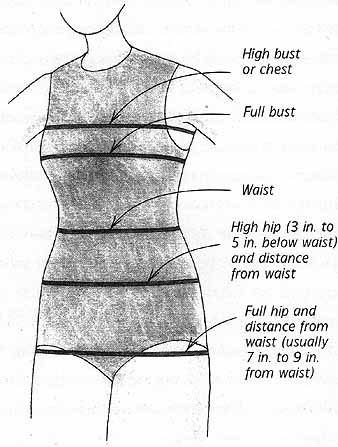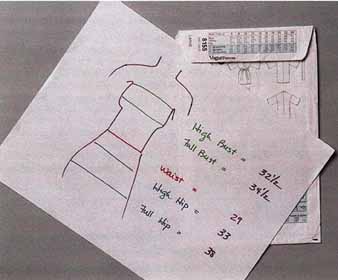Patterns are the blueprints for the garments we sew. Most of the time, we choose garments from the pictures in pattern books and on pat tern envelopes. There is a great deal of information on the pattern envelope that's actually more descriptive than the picture.
But before you buy a pattern, you need to gather some information.
Take your measurements

TAKING YOUR MEASUREMENTS: High bust or chest; Full bust; Waist;
High hip (3 in. to 5 in. below waist) and distance from waist; Full hip and distance from waist (usually 7-inch to 9-inch from waist)
First, you need to take basic measurements of yourself. These need to be honest measurements, and you don’t have to show them to anybody. When you take these measurements, hold the tape measure taut but not tight against the body. You don’t want to be too loose with the measurements. Regardless of the numbers, clothes that fit look good, so don’t cheat.
Take your bust (or for you guys out there, your chest) measurement, measured around the fullest part of your bust or chest. Next, ladies take your high bust measurement around the upper chest and under the arms. Take your waist measurement, then the full hip, which is measured around the widest part of you between your waist and knees. Follow this measurement with the distance between where you take your full hip measurement and your waist. Last, take your high hip measurement. This is typically 3 in. to 5 in. below the waist, where your hips or tummy get round. Take the distance from the high hip to your waist as well.
TIP: Many easy garments are loose fitting, which often means oversized or, to put it bluntly, baggy. It is easy to be disappointed when a T-shirt or pull-on pants turns out to be bigger than you think it will be, when it's actually as described. Be prepared: Loose-fitting garments are baggy.
== Wiki Sewing ==
Fabric Grain
Fabric grain is the way the threads (or fibers) that make up the fabric travel. If you've ever had a pair of jeans that wanted to twist or wrap around your leg instead of hang straight, you've experienced why cutting fabric on the straight grain is important-that twisting, wrapping jeans leg was not cut on the straight grain.
Lengthwise grain runs horizon tally to the selvedge or the length of the fabric. Lengthwise grain is usually used to run the length of a garment (a).
Crosswise grain runs perpendicular to the lengthwise grain.
Crosswise grain runs across or around a garment (b).
Bias grain is the grain that runs at a 45-degree angle to the straight grains of the fabric (c). Bias grain will hang differently and has stretch even on a woven, non-stretch fabric.
The photo on the right shows how fabric will stretch on the bias.
Examine the pattern envelope
The second step in choosing a pattern is to examine the information on the pattern envelope (see image below).

Both the front and back of the pattern envelope have information
you need to consider when choosing a pattern.
On the front of the envelope is the fashion picture, the pattern number, and the size or range of sizes in the envelope. It is important to look beyond the fashion drawing to the line drawing of the garment. Each pattern company will place the line drawing in different locations on the envelope, but this will give you a better description of the garment than the fashion drawing.
The line drawing not only outlines the garment but also outlines the shape of the pieces. You will know how many seams there are in each garment piece, where the seams are, and if there are details such as darts.
Look for the description of the garment. The pattern may simply say, “Very loose fitting,” or it may give a full description, “Loose fitting, lined, below-hip jacket has collar, collar band, forward shoulder seams, shoulder pads, flaps, welt pockets, back vents, long, two-piece sleeves, and concealed button closing.” For additional information about the garment you want to make, look for “finished lengths” or “pattern measurements” or “widths/lengths.” This is the information that will tell you how wide the bottom of each pants leg is, how wide a jacket is at the bottom edge, and how full a skirt will be when finished. Pay attention to the finished lengths if you are short or tall. This will give you some idea how much too long or short the garment is going to be and how much you will have to adjust the amount of yardage you need to buy.
Between the information you get from the line drawing, the written description, and the pattern measurements, you should have a good idea of what kind of project you are choosing. The more seams and details, the more difficult the project will be. The garment widths and lengths will cue you that alterations may be needed, and the description of the garment may steer you to another pattern that's more what you want.
Find the right pattern size
Next, you must determine the pattern size to buy. Forget everything you know about buying ready-to-wear; don’t assume that you are a size 10 pattern just because you have never bought anything but a size 10 in ready-to-wear since you were 16 years old. Chances are you won’t be a size 10 pattern. You are entering the foreign country of patterns now, and the numbers are different here.
Each of the major pattern companies bases its pattern sizes on a “sloper,” which is the standard shape for that company. The back pages of the pattern catalogs tell you the measurements for each pattern size. Be aware that each pat tern company’s sloper is different and may not have been adjusted for all the years the company has been in business.

Take out your list of measurements and compare it to the measurement chart on the pattern envelope or the size charts in the back pages of the pattern catalog (see image above).
If you are choosing a pattern from Burda, Neue Moda, Kwik Sew, or Stretch and Sew, find your measurements on the pattern company chart. You will make the size that corresponds to your measurements.
If you are choosing a pattern from Vogue, McCalls, Butterick, New Look, or Simplicity; find your measurements on the chart. If you are making a bottom (a skirt or pants), choose by finding the hip size that corresponds to your measurement. If you are making a top (a jacket, blouse, or even a dress), match the pattern’s full bust measurement with your high bust measurement and choose the size that corresponds. If you have a bust fuller than a B bra cup, it may be necessary for you to learn to alter the bust so that the pattern fits your figure.
There are an increasing number of boutique pattern companies offering a variety of pat terns, some of which may be available at your local fabric store. Each of these pattern compa flies is unique in its sizing. Ask questions at the fabric store, try on sample garments, and call the 800 number if there is one.
It’s confusing and even frustrating choosing a pattern that will fit and look good when the sizes are a far cry from what you’re used to and because they vary from pattern company to pattern company. My advice for beginning sewers is to choose garments that don’t have many details, don’t have a lot of pieces, and are somewhat loose fitting (yes, you can find easy- to-sew garments that are not baggy). When you have mastered basic sewing techniques, you can advance to garments that are closer fit ting and have more details and pattern pieces. You can then make simple alterations to the patterns for a better, personal fit. (See “Multi-size Patterns” below.)
Multi-size Patterns Today many patterns are multi— size, which means that each pat tern contains a range of sizes. From some companies, patterns are offered in 6-8-10 or 12-14-16; from others, all sizes will be offered in one pattern. As a general rule, buy and plan to make the pattern based on your bust size, adding if necessary to the waist and hips. Of course, if you are just making a skirt or a pair of pants, buy the size based on your hip measurement. When you are ready to cut out the pattern pieces, find the size chart and circle the size you need for your bust, waist, and hips. In multi-size patterns, note that each size has a different cutting line—a zigzag, a dotted line, a line of dots and dashes. Find the size you need on the pattern pieces, and put an X on it if you need to. If you need to cut the size 10 top, the size 12 waist, and the size 14 hip, put an X on the line where you need the pat tern to be that size. With a pencil, draw transition lines from one point to the other. Be sure to keep the shape of the garment, curving toward the waist and out to the hip. While it's easier to buy a size range, you still have to know what size you are in order to buy fabric and to know if the pattern will fit. |
Sewing Basics -- A Quick-start Guide
Before you begin sewing, know about ...
- Fabric
- Basic sewing tools
- Beyond the basic tools
- Choosing a pattern
- Choosing fabric
- Layout and cutting
- Marking the pieces
- Introduction to the sewing machine
